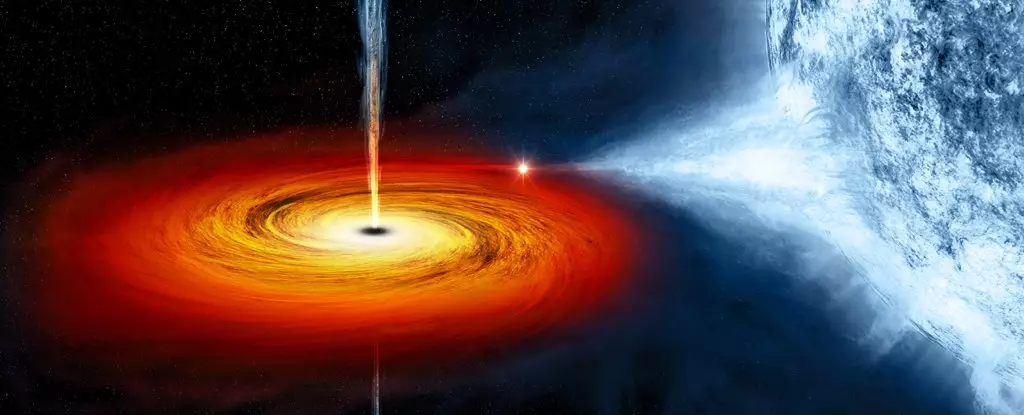For decades, astronomers have focused their attention on the tumultuous beasts that are supermassive black holes, particularly in quasars located at the edges of the observable universe, to understand the origins of the highest-energy gamma rays. However, the recent findings regarding V4641 Sagittarii challenge this established narrative. Located a mere 20,000 light-years away from Earth, this microquasar reveals that the genesis of high-energy gamma rays isn’t exclusively the territory of these far-off cosmic titans but can also emerge from closer, less colossal systems.
The V4641 Sagittarii system features a black hole with a mass approximating six times that of our Sun, actively drawing in materials from a massive companion star approximately three solar masses in size. This interplay is not just an astronomical curiosity but a dynamic and potent source of intense radiation akin to what might occur in a gigantic particle accelerator. The astronomical community is buzzing with the revelation that gamma rays emerging from V4641 Sagittarii can reach energy levels of up to 200 teraelectronvolts (TeV). To contextualize this staggering energy level, this value is 200 trillion times stronger than visible light, marking it as one of the highest recorded photon energies in the universe.
Previously, scientists mostly attributed the emission of such formidable gamma rays to vast quasars, where supermassive black holes efficiently convert gigantic amounts of infalling gas into energy. Traditionally thought to be less effective in generating gamma rays due to their comparatively smaller scale, microquasars like V4641 Sagittarii turnover this assumption, showcasing that they can produce radiation on par with their larger counterparts.
The pivotal observations originated from the High-Altitude Water Cherenkov (HAWC) observatory located on the Sierra Negra volcano in Mexico. This observatory features 300 large tanks filled with purified water, meticulously designed to detect high-energy particles racing across the cosmos. The innovative technology used by HAWC captures the flashes of Cherenkov radiation produced when high-energy particles enter the water at speeds surpassing that of light in the medium.
HAWC’s vast coverage—15 percent of the sky at any moment and the ability to scan two-thirds of the entire sky every day—has rendered it a valuable tool for mapping cosmic radiation. In the course of this cosmic cartography, V4641 Sagittarii was unearthed as an unexpected hotspot of gamma rays, illuminating a region of the sky previously overlooked. Xiaojie Wang, the physicist who spearheaded the analysis effort, emphasized the excitement of uncovering this new gamma-ray source in what seemed to be uncharted territory.
Upon delving deeper into the data, researchers began to realize that V4641 Sagittarii was emitting gamma rays at energy levels that rival those from supermassive black holes. This overturned conventional perceptions regarding microquasars, which were not thought capable of producing such immense energies. While some microquasars, like SS 433, have been documented emitting photons at energies exceeding 25 TeV, the output from V4641 Sagittarii elevates the entire category, presenting a newfound perspective on these cosmic entities.
This phenomenon provides a captivating glimpse into processes that typically unfold over millions of years in quasar systems. Microquasars operate on a much faster timescale, executing similar astrophysical processes within mere days. This swift cycle presents an experimental platform for astrophysicists who wish to study high-energy radiation without the excessive timescales associated with larger quasars.
The implications of V4641 Sagittarii’s discoveries are manifold and transformative. This observation not only heightens our understanding of gamma rays but also compels astrophysicists to rethink the fundamental mechanisms driving high-energy emissions across a spectrum of cosmic phenomena. As researchers continue to analyze and understand this microquasar, insights into black hole physics, stellar interactions, and particle acceleration mechanisms may emerge, further unraveling the complex tapestry of our universe.
The revelations regarding V4641 Sagittarii enrich our understanding of cosmic radiation and demonstrate that astrophysical phenomena are often more nuanced and interconnected than previously believed. Through meticulous observation and innovative technology, we stand on the brink of redefining our understanding of the cosmos, reminding us that even in familiar territories, the universe still harbors surprises waiting to be unveiled.


Leave a Reply